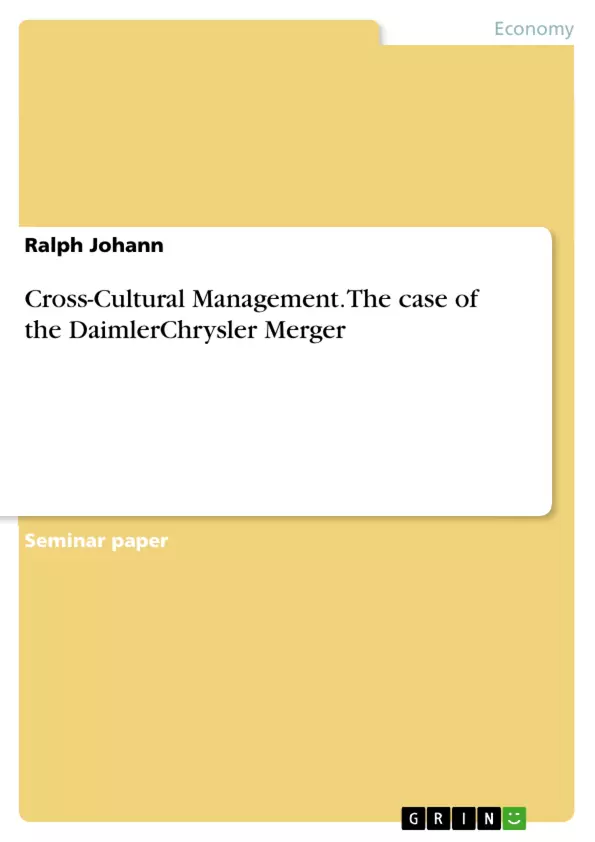On 6 May 1998, Daimler-Benz of Germany signed a merger agreement with Chrysler
Corporation of the United States. The merger marked the beginning of the ambitious goal of
merging two styles of auto-making, two approaches to business and the proud, but distinct
cultures of two nations. The opportunities for significant synergies afforded by a combination
based on factors such as shared technologies, distribution, purchasing and know-how. Daimler’s
engineering skill and technological advances could be complemented by Chrysler’s skills for
innovation, speed in product development and bold marketing style. Juergen Schrempp, CEO of
DaimlerChrysler, said, that the new company will reach an eminent strategic position in the
global marketplace by combining and utilizing each other’s strengths. It seems that Germans and
Americans in the enterprise have not become closer since the merger. This paper explores the
reasons for DaimlerChrysler's failure to realize the synergies identified prior to the merger. It
examines the different culture and management styles of the companies that were primarily
responsible for this failure. The focus will be on the cultural issues and on the different theories
that try to explain cultural differences between nations – the US and Germany - and how values
in the workplace are influenced by those cultures. First of all it describes the overall
circumstances that led to the merger. Both companies and their conditions prior to the merger are
introduced as well as the general objectives that led to the merger and the goals of it are
highlighted. After that, some of the theories that try to explain cultural differences such as the
Cultural Dimensions of Hofstede are introduced with a special focus on the differences between
the two cultures in play, the German and the US. It will proceed with an analysis of the different
corporate cultures and the accompanying communication difficulties and mistakes that have been
done in this context. The paper will conclude with recent developments, the current situation of
DaimlerChrysler and some recommendations to work on the existing cultural issues and other
problems within the merged company.
Table of Contents
- Introduction
- General background information about the DaimlerChrysler merger
- The Merger Objects - Chrysler Corporation and Daimler Benz AG
- The 'Deal' - Preconditions and Expectations
- Cultural Differences between Americans and Germans - Theories on Cross Cultural Management
- Hofstede's Cultural Dimensions
- Trompenaars's Seven Dimensions of Culture
- Cultural Orientations Framework-Mapping
- Two different Corporate Cultures
- The new Corporate Structure
- Communication Issues
- Differences in Corporate Cultures and Management Styles
- Conclusion
- References
- Appendix
Objectives and Key Themes
This paper investigates the DaimlerChrysler merger, examining the reasons for its failure to achieve the expected synergies. It explores the impact of cultural differences between the American and German companies involved, particularly focusing on the role of different management styles and workplace values.
- The merger process and the objectives of the DaimlerChrysler collaboration
- Cultural differences between American and German corporate cultures
- Theories explaining cross-cultural management, particularly Hofstede's Cultural Dimensions
- The impact of cultural differences on corporate communication and management styles
- The challenges of integrating two distinct corporate cultures
Chapter Summaries
The paper begins by providing a detailed overview of the DaimlerChrysler merger, including the history of the companies involved and the rationale for the merger. This section highlights the expectations for synergy and the anticipated benefits of combining the strengths of both companies.
The subsequent section delves into the cultural differences between American and German corporate cultures, utilizing Hofstede's Cultural Dimensions as a framework for analysis. This analysis emphasizes the contrasting management styles and workplace values prevalent in both nations.
The paper then examines the specific challenges posed by the merging of these distinct corporate cultures. This includes an exploration of communication issues and the difficulties encountered in integrating diverse management approaches.
Keywords
This paper examines the case of the DaimlerChrysler merger, focusing on cross-cultural management and the challenges of integrating two distinct corporate cultures. It investigates key themes such as cultural dimensions, workplace values, communication, and management styles, utilizing theories like Hofstede's Cultural Dimensions.
- Arbeit zitieren
- Ralph Johann (Autor:in), 2006, Cross-Cultural Management. The case of the DaimlerChrysler Merger, München, GRIN Verlag, https://www.grin.com/document/114405



